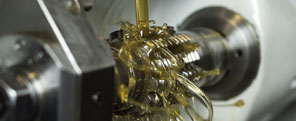 |
|||||||
|
The primary function of cutting fluid is to cool and lubricate the interface between a tool and workpiece. The application of cutting oil also helps flush away coarse metal chips and fine particulates ("swarf") from the workpiece surface. However, as cutting fluid recirculates, small fines inevitably find their way into the system and build up over time. This build-up, if left unchecked, will adversely affect the entire machining fluid system and result in problems such as resistance to filtration, poor part quality, less effective rust protection or health issues for the machine operator. Filtration Is the Most Common Remedy Different types of filtering equipment are available for fines removal. These may be sophisticated central systems serving numerous machines, or movable units that can be wheeled up to recycle fluid from an individual machine. These units use filter media such as a bag filter or a magnetic filter (for use with ferrous metals) or a combination of these. Some manufacturers recommend the use of pre-coated filtration media. These use absorbent materials such as diatomaceous earth, cellulite for straight oils or alpha cellulose for water soluble cutting oils. Do You Have a Fines Problem? Note that different fluids have different settling rates. Synthetic and semi-synthetic cutting oils have the quickest settling rates. Straight mineral oils offer slower settling times. Also be aware that tramp oils, which made their way from the machine into the cutting oil system, will affect particle settling. The settling properties of all types of cutting fluids are affected by the presence of tramp oils. Tramp oils tend to form droplets, especially in synthetic and semi-synthetic fluids, which attract fines that adhere to them and prevent them from settling. The best defense against this is to minimize the intrusion of tramp oils. If the problem persists, the addition of an oil-dispersing agent will float some fines to the surface. Hard water also prevents fines from settling. The hard water actually inhibits emulsifiers in soluble and semi-synthetic oils from doing their job, preventing fines from properly settling out. High-viscosity natural mineral oils also have slower settling properties. In such viscous fluids, the finer the particle, the longer it will take to settle out. This is not surprising, but it is something to consider when selecting oils for a given application. All else being equal, the less viscous fluid will not only help fines settle more easily, but will also remove heat from the cutting surface more quickly. Let Acculube Get You out of Your Fine Mess
|

|
||||||
|
|||||||
|
|||||||
Accurate Lubricants & Metalworking Fluids, Inc.• 403 Homestead Avenue; Dayton, Ohio 45417 USA • Phone: 937-461-9906 Fax: 937-461-9917
|
|||||||
